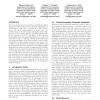Free Online Productivity Tools
i2Speak
i2Symbol
i2OCR
iTex2Img
iWeb2Print
iWeb2Shot
i2Type
iPdf2Split
iPdf2Merge
i2Bopomofo
i2Arabic
i2Style
i2Image
i2PDF
iLatex2Rtf
Sci2ools
KDD
2002
ACM
2002
ACM
Generalization Methods in Bioinformatics
Protein secondary structure prediction and high-throughput drug screen data mining are two important applications in bioinformatics. The data is represented in sparse feature spaces and can be unrepresentative of future data. Supervised learners in this context will display their inherent bias toward certain solutions, generally solutions that t the training set well. In this paper, we rst describe an ensemble approach using subsampling that scales well with dataset size. A su cient number of ensemble members using subsamples of the data can yield a more accurate classi er than a single classi er using the entire dataset. Experiments on several datasets demonstrate the e ectiveness of the approach. We report results from the KDD Cup 2001 drug discovery dataset in which our approach yields a higher weighted accuracy than the winning entry. We then extend our ensemble approach to create an over-generalized classier for prediction by reducing the individual subsample size. The ensemble s...
Data Mining | Drug Discovery Prediction | KDD 2002 | Protein Secondary Structure | Secondary Structure Prediction |
| Added | 30 Nov 2009 |
| Updated | 30 Nov 2009 |
| Type | Conference |
| Year | 2002 |
| Where | KDD |
| Authors | Steven Eschrich, Nitesh V. Chawla, Lawrence O. Hall |
Comments (0)

